Mediaprobe Neuro Study Smashes The “Sight, Sound, And Motion” Myth: AM/FM Radio Advertising Is +12% More Engaging Than TV Ads
Click here to view an 11-minute video of the key findings.
Click here to download a PDF of the slides.
Mediaprobe, a leader in neuro creative testing, measures the emotional impact of media content and advertising. Their clients include NBCU, World Athletics, TikTok, Amazon, and Spotify to name a few. Last week at the Advertising Research Foundation’s AUDIENCExSCIENCE conference, Mediaprobe presented a major new study on audio effectiveness.
In a never-before conducted study, Mediaprobe measured second-by-second electrodermal activity (EDA) and dial data on the response of respondents to pre-recorded AM/FM radio segments in various genres for the purpose of understanding overall strength of ad engagement, brand fit, and recall of the AM/FM radio ads.
227 adult 18+ respondents participated. The study took place June 26–July 7, 2023.
The key learning objectives were understanding the emotional signature of successful AM/FM radio ads and comparing Mediaprobe AM/FM radio benchmarks against their overall TV norms.
Five key findings:
- Despite lacking “sight, sound, and motion,” AM/FM radio programming was +13% more engaging than Mediaprobe’s norm for television in the U.S. For advertisers, this means the AM/FM radio context for their ads has greater engagement than the TV context.
- Overall, AM/FM radio advertising’s Emotional Impact Score (EIS) outperformed TV advertising by +12%. These new findings validate the recently released Dentsu/Lumen study, which revealed audio ads outperform video for attention and brand recall.
- AM/FM radio News was the most impactful genre, consistently measuring as a high-quality contextual environment for advertising (+14% greater than Mediaprobe TV News norms and +8% than total AM/FM radio).
- Mediaprobe audio benchmarks reveal the sound contrast between AM/FM radio programming and the ads drives higher attention and brand recall. For example, ads with music and jingles perform very well in spoken word programming due to the contrast.
- Creative best practices: Use female voiceovers, jingles, and include five brand mentions.
The Mediaprobe Electrodermal Sensor fits into the palm of your hand and allows out-of-lab and real-time measurement of unconscious reactions to ads and media content, providing an accurate assessment of the audience’s attentiveness and engagement
Consumers in the Mediaprobe panel participate in the comfort of their home. Participants slip the Mediaprobe sensor into their palm and watch or listen to assigned media content.
The sensor picks up and measures electrodermal activity – changes in the electrical conductance of skin – that is a tried and tested, valid and robust measure of emotional engagement.
The results from the Mediaprobe sensor are synced to the moments from the TV show, TV ad, audio content, and audio ads. Mediaprobe’s Emotional Impact Score is calculated from the electrodermal activity of the audience exposed to content.
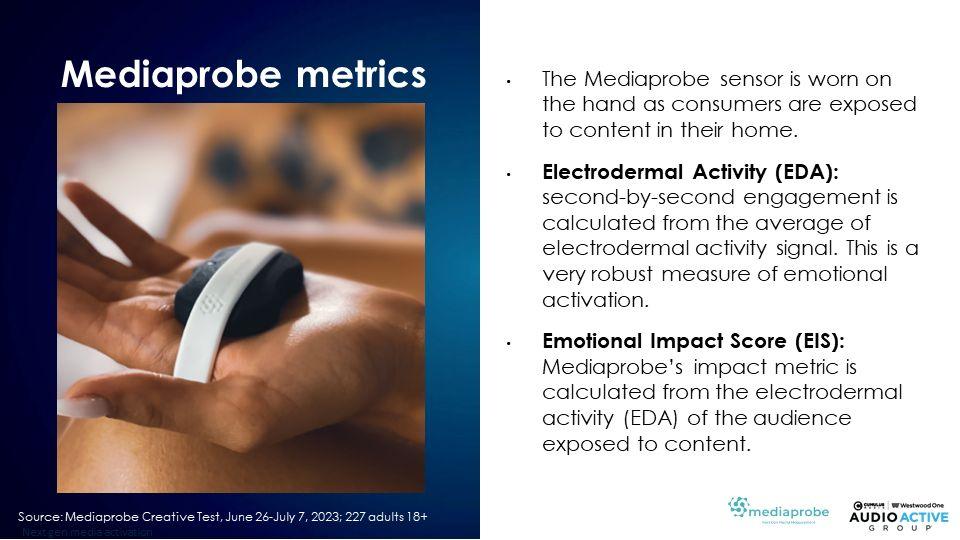
Unconscious reactions get to the heart of what consumers really feel about media and ads
Advertising legend David Oglivy famously said, “Consumers don’t think how they feel. They don’t say what they think and they don’t do what they say.” This makes researching consumers challenging.
People might come up with reasons why they buy certain products or what they think of an ad. But often, they are just trying to rationalize their unconscious reactions. That’s why neuro studies are so interesting, as they measure the unconscious responses of consumers.
In his book Alchemy: The Dark Art and Curious Science of Creative Magic in Brands, Business and Life, Rory Sutherland, Vice Chairman, Ogilvy Advertising, reveals most decisions are made unconsciously not rationally.
Sutherland explains, “In the words of Jonathan Haidt, ‘The conscious mind thinks it’s the Oval Office, when in reality it’s the press office.’ By this he means that we believe we are issuing executive orders, while most of the time we are actually engaged in hastily constructing plausible post-rationalizations to explain decision taken somewhere else, for reasons we do not understand. But the fact that we can deploy reason to explain our actions post-hoc does not mean it was reason that decided on that action in the first place, or indeed that the use of reason can help obtain it. Much of the time we pretend that conscious human agency is the only force that drives our behavior, and therefore disparage other less obvious behaviors that we have adopted to hack our unconscious processes as if they were irrational, wistful or absurd.”
“It’s good because it’s good!”
Legendary AM/FM radio researcher Jon Coleman relates the story of a focus group he conducted of AM/FM radio listeners. He asked respondents in the room to name the one AM/FM radio station they listened to the most.
One woman named the local Country AM/FM radio station the one she listened to most. Jon asked the women why the station was her favorite. “It’s good!” was the woman’s response. Following up, Jon asked what about the station was good. “It’s just good!” said the woman.
Jon followed up again about what she liked about the AM/FM radio station. “Sonny, it’s good because it’s good!” snapped the woman.
Emotion guides and simplifies our decisions
In their book System1: Unlocking Profitable Growth, John Kearon, Orlando Wood, and Tom Ewing explain, “We think much less than we think we think.”
Kearon, Wood, and Ewing apply the work of Princeton University psychologist Daniel Kahneman, PhD to the world of advertising creative. Kahneman was awarded the Nobel Memorial Prize in Economic Sciences for his groundbreaking work in applying psychological insights to economic theory, particularly in the areas of judgment and decision-making.
Kahneman’s bestselling book Thinking, Fast and Slow highlights System 1, the primary way people make decisions. System 1 decisions are quick, instinctive, and driven by emotion and experience.
Kearnon, Wood, and Ewing explain that emotionis essential to making judgments. Of the seven emotions identified by psychologist Paul Ekman, only one, happiness, is truly positive. If something makes us feel happy, our System 1 decides it’s probably a good option.
Positive emotional responses lead to a positive evaluation of choice. Kahneman says, “The answer to a simple question – how do I feel about it? – is an excellent proxy for the answer to [the] far more complex question – how do I think about it?” According to System1, the creative testing firm, “Emotion guides and simplifies our decisions.”
Mediaprobe study design: Consumers were exposed to half-hour AM/FM radio shows
Consumers were exposed to four half-hour AM/FM radio broadcasts consisting of actual AM/FM radio programming across four genres: Urban, All News, Adult Contemporary/Pop, and Rock/Classic Hits. Each broadcast had three ad breaks and a total of 36 ads tested from a variety of national brands.
Consumers listened to three of the four broadcasts. Each ad was exposed to 225 people. Mediaprobe compared the results of this AM/FM radio study to their extensive database of TV studies from the U.S.
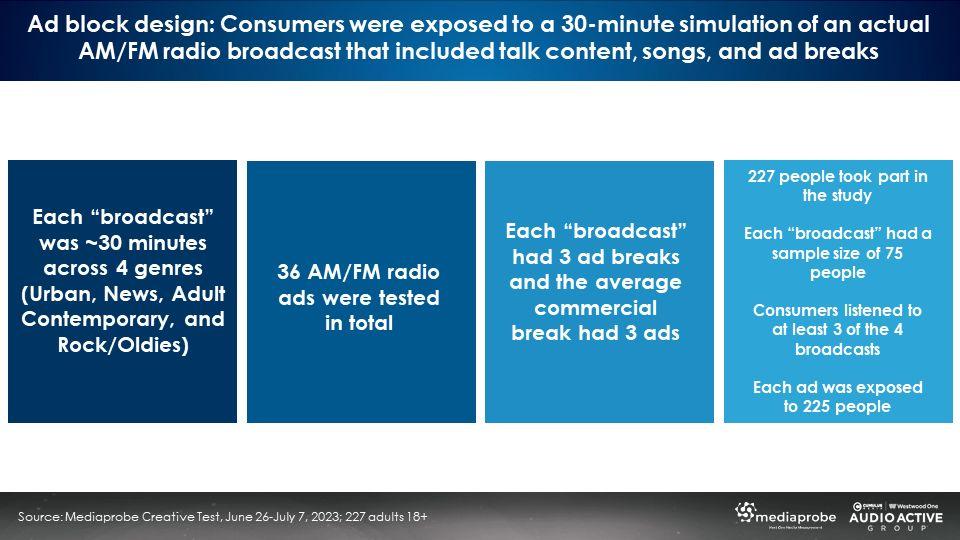
Head snapper: Despite the lack of “sight, sound, and motion,” the Emotional Impact Score of AM/FM radio programming and ads outperformed TV by +12% to +13%
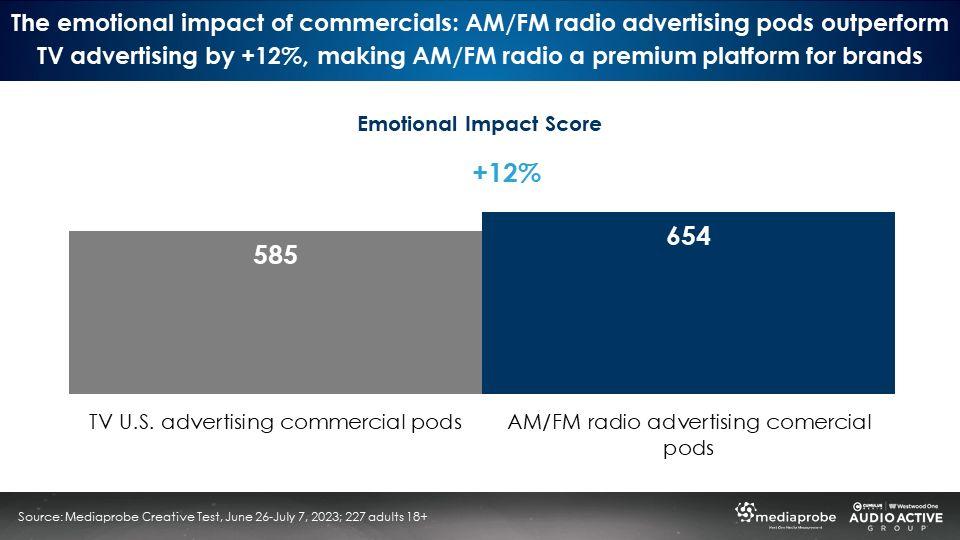
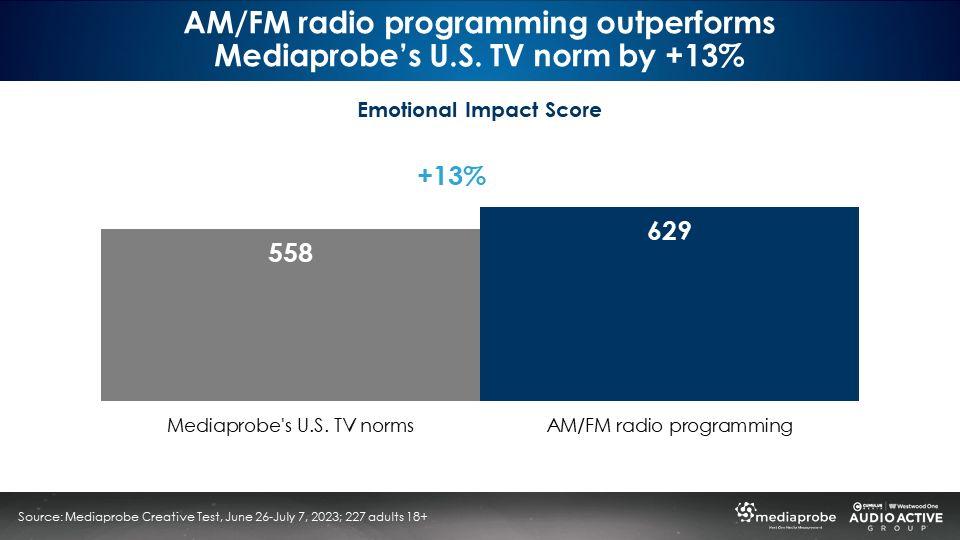
Despite lacking “sight and motion,” individual AM/FM radio ads have a +5% greater Emotional Impact Score than TV ads
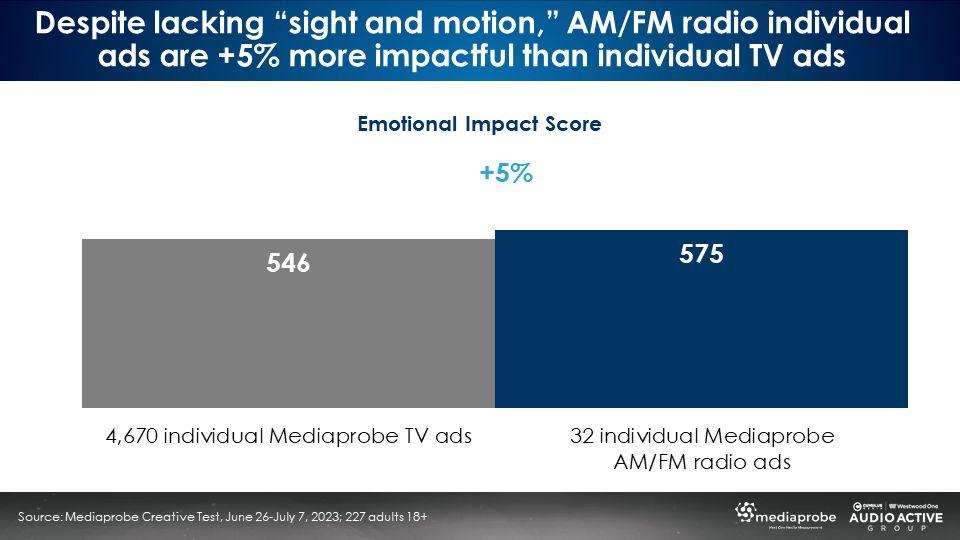
AM/FM radio News is the most impactful genre, outperforming TV News by +14%
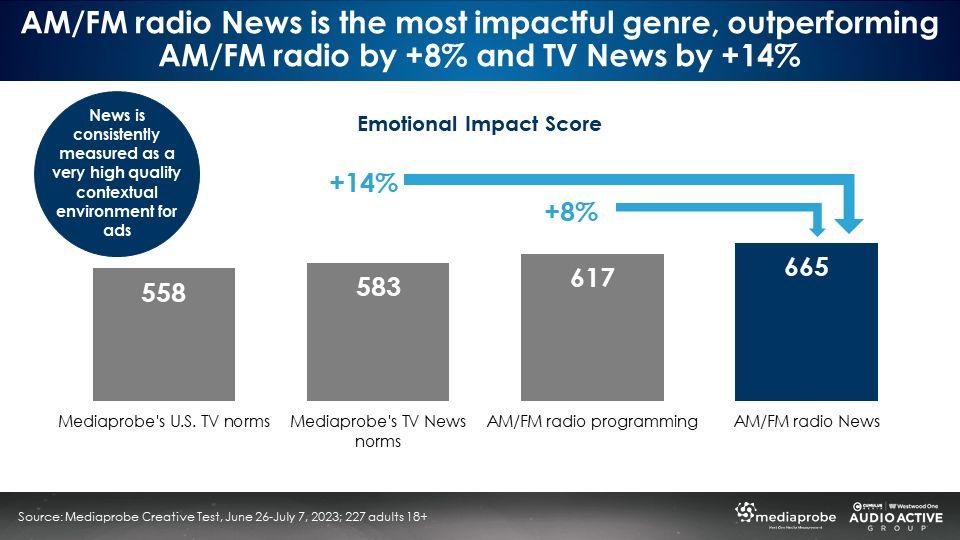
Creative best practices: Use female voiceover, jingles, music, and five brand mentions
Via a statistical process called regression analysis, Mediaprobe was able to identify the creative elements that drove the strongest emotional impact.
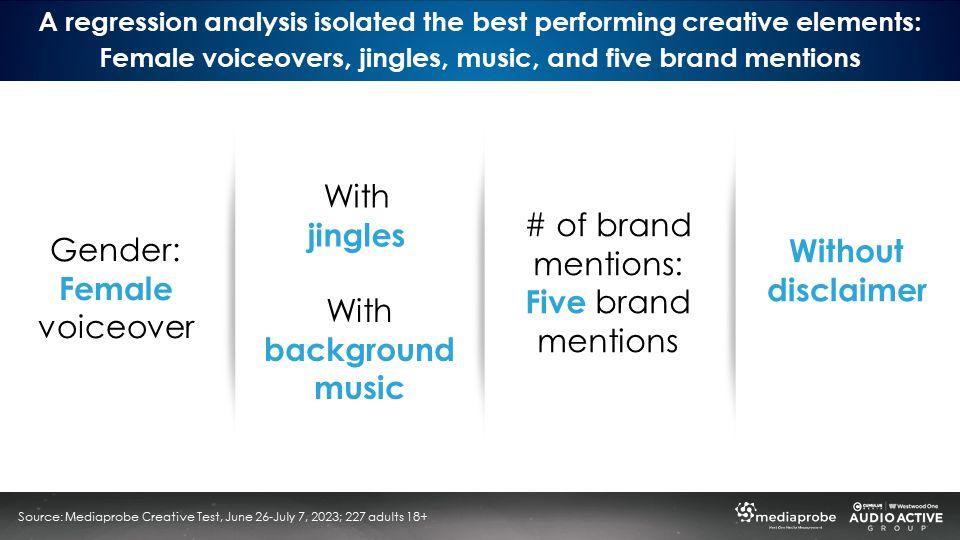
Nielsen: Brand early and often for greatest impact
Mediaprobe found audio ads with 5+ brand mentions had the strongest Emotional Impact Score. This “brand early and often” recommendation is one of the most powerful audio creative best practices.
Want to improve your audio creative effectiveness? Have the advertised brand appear within the first few seconds and say the brand at least five times in the thirty-second ad. This key recommendation has been validated by thousands of Nielsen brand effect studies.
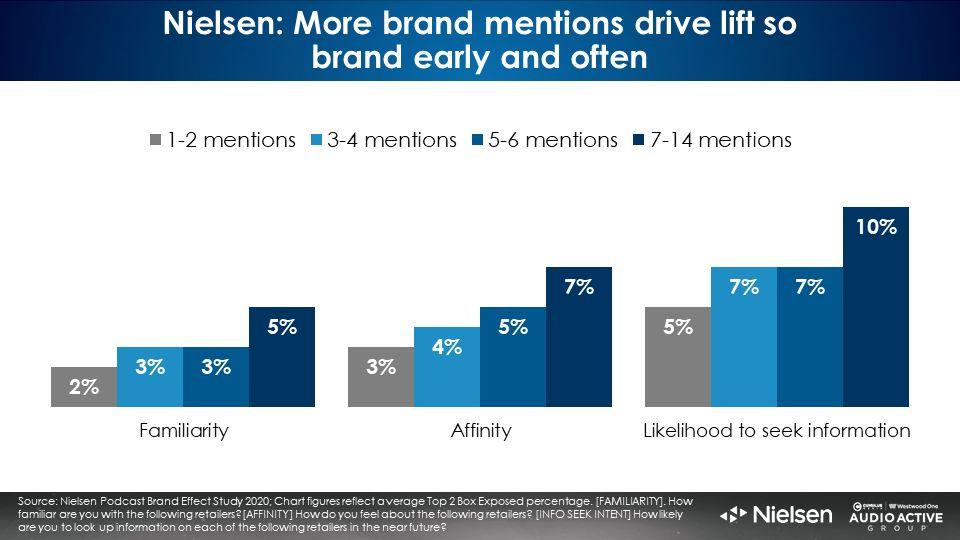
Nielsen reports significant lift in familiarity, affinity, and likelihood to seek information based on the number of brand mentions in audio ads.
Five key findings:
- Despite lacking “sight, sound, and motion,” AM/FM radio programming was +13% more engaging than Mediaprobe’s norm for television in the U.S. For advertisers, this means the AM/FM radio context for their ads has greater engagement than the TV context.
- Overall, AM/FM radio advertising’s Emotional Impact Score (EIS) outperformed TV advertising by +12%. These new findings validate the recently released Dentsu/Lumen study, which revealed audio ads outperform video for attention and brand recall.
- AM/FM radio News was the most impactful genre, consistently measuring as a high-quality contextual environment for advertising (+14% greater than Mediaprobe TV News norms and +8% than total AM/FM radio).
- Mediaprobe audio benchmarks reveal the sound contrast between AM/FM radio programming and the ads drives higher attention and brand recall. For example, ads with music and jingles perform very well in spoken word programming due to the contrast.
- Creative best practices: Use female voiceovers, jingles, and include five brand mentions.
Click here to view an 11-minute video of the key findings.
Pierre Bouvard is Chief Insights Officer of the Cumulus Media | Westwood One Audio Active Group®.
Contact the Insights team at CorpMarketing@westwoodone.com.